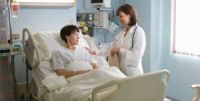Study Shows Effectiveness of Ultraviolet Light in Hospital Infection Control
Specific spectrum of UV light can effectively kill drug-resistant VRE, c. diff, and other sources of serious hospital-associated infections.

San Diego, CA (October 18, 2012) — Research being presented at IDWeek 2012™ shows that a specific spectrum of ultraviolet light killed certain drug-resistant bacteria on the door handles, bedside tables and other surfaces of hospital rooms, suggesting a possible future weapon in the battle to reduce hospital-associated infections.
Researchers at Duke University Medical Center and the University of North Carolina Hospital System used short-wave ultraviolet radiation (UV-C) to nearly eliminate Acinetobacter, Clostridium difficile or vancomycin-resistant enterococci (VRE) in more than 50 patient rooms at the two medical facilities.
“We’re learning more and more about how much the hospital environment contributes to the spread of these organisms,” said lead researcher Deverick J. Anderson, MD, an assistant professor of medicine at Duke and co-director of the Duke Infection Control Outreach Network. Given previous findings by the University of North Carolina team that UV-C is effective at decreasing methicillin-resistant Staphylococcus aureus (MRSA) in hospital rooms, he believes that the new study lays critical groundwork.
“We have a solid foundation to show that this approach succeeds in both experimental and real-world conditions,” Anderson said. “Now it’s time to see if we can demonstrate that it indeed decreases the rate of infections among patients.”
His group’s work is among the significant research being discussed at the inaugural IDWeek meeting, taking place through Sunday in San Diego. With the theme Advancing Science, Improving Care, IDWeek features the latest science and bench-to-bedside approaches in prevention, diagnosis, treatment, and epidemiology of infectious diseases, including HIV, across the lifespan. More than 1,500 abstracts from scientists in this country and internationally will be highlighted over the conference’s five days.
“Healthcare-associated infections are linked with significant morbidity and mortality,” said Liise-anne Pirofski, MD, an IDWeek chair for the Infectious Diseases Society of America. “Although there are multiple sources for these infections, the hospital environment itself can play an important role. The findings of this study suggest that UV light could hold promise for eliminating bacteria from hospital rooms and reducing the risk of infection with these difficult bacterial pathogens in the healthcare environment. That would be a result to benefit us all.”
UV-C, which is harmful to microorganisms, has been used for decades in food, air and water purification and to sterilize equipment in laboratory settings. This study demonstrates that its medical application may offer new strategies for reducing the estimated 1.7 million hospital-associated infections that occur annually in the United States. The cost of treating these infections, often involving increasingly antibiotic-resistant bacteria, ranges from an estimated $4.5 billion to as much as $11 billion.
In their study, the Duke and University of North Carolina researchers questioned whether UV-C could be utilized to eliminate three of the most problematic germs and improve the cleanliness of patient rooms. Given the tough economics of healthcare today, hospitals’ environmental services are under pressure to turn rooms over quickly, and many surfaces can get missed by even the most diligent crews.
The study focused on general-medical and intensive-care units of the two medical centers and identified patients with infections from the targeted bacteria. Clostridium difficile, or C. diff as it is commonly known, can trigger serious intestinal conditions. Acinetobacter can cause pneumonia and serious blood, wound and urinary tract infections. VRE most frequently infects the urinary tract, bloodstream, wounds or catheter sites. Each bacterium can survive for prolonged periods on surfaces.
After the patients were discharged, the researchers obtained multiple cultures from each of five specific locations in the hospital rooms and bathrooms — “high-touch” areas that included bed rails, remote controls and toilets. A special machine with eight UV bulbs mounted on a central column was then positioned strategically in each room and turned on for as long as 45 minutes to eradicate both vegetative bacteria and bacterial spores. Fifteen more cultures were taken from the same locations in every room, and the pre- and post-treatment bacteria counts were compared.
The numbers of bacterial CFUs, or colony-forming units, fell precipitously. Fifty-two CFUs of Acinetobacter were seen before irradiation, but only 1 CFU afterward — down 98.1 percent. As for VRE, the proportion decrease was nearly the same – 719 CFUs before and 15 after, a 97.9 percent drop.
The culturing initially was not sensitive enough to isolate C. diff, but improved techniques allowed the researchers to do further testing and the results in the UV-C treated rooms were just as dramatic.
“We would never propose that UV light be the only form of room cleaning, but in an era of increasing antibiotic resistance, it could become an important addition to hospitals’ arsenal,” Anderson said.
Source: IDWeek